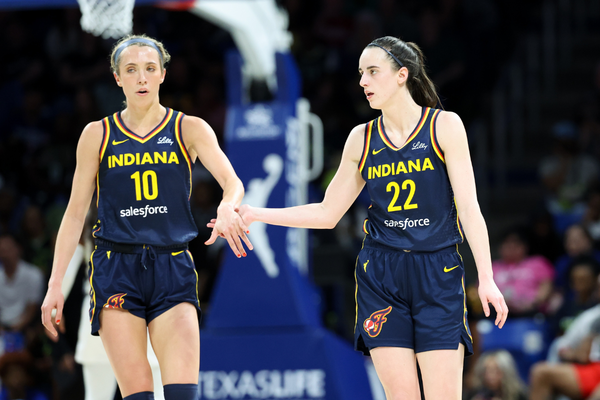
via Imago
Image Credit: IMAGN

via Imago
Image Credit: IMAGN
The WNBA landscape is shifting dramatically with expansion teams popping up across the map, creating new opportunities and tough decisions for players. The Portland Fire’s arrival in 2026 has sparked fan speculation about which Indiana Fever stars might make the move west. This chatter often includes young standouts looking for bigger roles, putting families in the middle of basketball’s business side. Indiana Fever has been at the center of these discussions all season, largely due to the uncertain futures and current challenges faced by its young stars. Caitlin Clark has been sidelined since mid-July with a groin injury, missing around 18 consecutive games, while Lexie Hull has continued to play through visible bruises after a hard collision with Seattle’s Gabby Williams.
Hull’s toughness drew praise from her coach Stephanie White, who said, “It really epitomizes Lexie’s toughness when you look at her, and you see those two black eyes. I mean, she’s tough as nails.” The Fever’s challenges, combined with the looming expansion of Portland and the financial power of Seattle, have sparked conversations about whether this young core could eventually leave Indiana. This speculation hit a little closer to home recently during a casual online conversation. A fan theory about player movement suddenly got a very real and personal response from someone who would know best—Lexie Hull’s mother, Jaime Hull herself.
YouTube host Rosalina Lee found this out firsthand when a viewer suggested during a live chat that “Lexi, Sophie, and Cece to Portland in 2026.” The comment prompted an immediate and telling response from her guest, Jaime Hull, mother of Fever guard Lexie Hull. “No, that’s a six-hour drive for me,” Jaime Hull stated, before adding a crucial comparison about another potential destination: “It’s a lot better than the other place other than Seattle.” This offhand remark reveals the personal calculations families make when considering team changes.
ADVERTISEMENT
Article continues below this ad

USA Today via Reuters
Mandatory Credits: Grace Smith/IndyStar / USA TODAY NETWORK via Imagn Images
The broader picture shows how quickly the business has grown around these conversations. Seattle’s $325 million valuation comes at a time when Indiana itself ranks second on the Forbes list at $370 million, powered by Clark’s marketability and a league-leading $32 million in revenue last season. This financial muscle makes Seattle a potential powerhouse in any free agency or trade discussion, but as Jaime Hull’s comment suggests, it might not be the preferred destination for everyone, regardless of money or prestige.
For families like the Hulls, that growth means potential moves are not just about geography but also about competing with financial realities that would have been unthinkable a decade ago. Consider that the Liberty, now worth around $400 million to $450 million, sold for between $10 and $14 million in 2019. The scale of change puts added weight on Jaime Hull’s casual remark.
Her perspective also highlights the strength of Indiana’s current group. She has often said Lexie is closest with Caitlin Clark and Sophie Cunningham, with the three and their partners spending time together outside basketball. “This group is tight as tight can be,” Jaime Hull has emphasized in the past, underscoring how chemistry has carried the Fever through adversity. That bond makes the idea of splitting them in an expansion draft feel less likely, though the league has not yet finalized its rules on how many players a team can protect. As the Fever push toward the playoffs without Clark and Cunningham, the depth of these friendships remains one of their most valuable assets, bridging the gap between speculation and reality.
ADVERTISEMENT
Article continues below this ad
Forbes rankings reshape WNBA expansion conversations
The release of Forbes’ first-ever WNBA team valuations has reset the conversation about expansion and player movement. The Seattle Storm’s $330 million valuation sits directly behind Indiana at $370 million and New York at $400 million. Those numbers reflect an average valuation of $272 million across the league’s 12 current teams, a figure that represents a 14.4x multiple on revenue. To put it simply, women’s basketball has become one of the fastest-appreciating properties in all of professional sports.
What’s your perspective on:
Could the Fever's tight-knit chemistry be the key to resisting the WNBA's expansion draft?
Have an interesting take?

via Imago
BOSTON, MA – JULY 15: Indiana Fever guard Caitlin Clark 22 looks on during a WNBA, Basketball Damen, USA game between the Indiana Fever and the Connecticut Sun on July 15, 2025, at TD Garden in Boston, MA. Photo by Erica Denhoff/Icon Sportswire WNBA: JUL 15 Indiana Fever at Connecticut Sun EDITORIAL USE ONLY Icon25071503
This rapid rise is reflected in the fees expansion teams now pay to join the league. Golden State’s Valkyries entered in 2023 for $50 million, while Portland paid $125 million for its 2026 return. By contrast, Cleveland, Detroit, and Philadelphia each committed $250 million for franchises set to debut between 2028 and 2030. For comparison, the Las Vegas Aces were purchased for just $2 million in 2021. These escalations demonstrate how valuations are shaping the next chapter of the WNBA, influencing where stars like Clark and Hull might eventually play.
ADVERTISEMENT
Article continues below this ad
Investors are betting heavily on the Caitlin Clark effect but also on the strength of stars like Angel Reese and Paige Bueckers, whose combined social media reach surpasses Clark’s 4.4 million followers. With the new $2.2 billion media rights package beginning in 2026, teams are positioning themselves for an entirely different financial reality. In that climate, Jaime Hull’s simple point about travel distance carries weight. The next wave of expansion will not just be about where teams can sell tickets but about whether players and their families feel rooted enough to stay put or tempted enough to move.
ADVERTISEMENT
ADVERTISEMENT
ADVERTISEMENT
ADVERTISEMENT



Could the Fever's tight-knit chemistry be the key to resisting the WNBA's expansion draft?